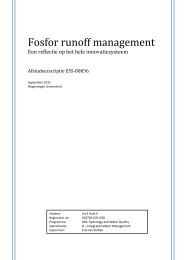Download PDF (English) - Future Ideas
Download PDF (English) - Future Ideas
Download PDF (English) - Future Ideas
You also want an ePaper? Increase the reach of your titles
YUMPU automatically turns print PDFs into web optimized ePapers that Google loves.
Master thesis (in progress) Business Administration, Specialization: Strategy & Organization <br />
Supervisor: Prof. Dr. T. Elfring <br />
Joost de Boer <br />
Student number 1517597 <br />
few is known about which internal and external parties are exactly involved during these particular phases in <br />
the process. Considering the external parties that are involved, it might be that these are not just customers, <br />
but also a more varied group of stakeholders. In addition, considering the involvement of internal parties, there <br />
might be problems when cooperation between departments is intensified as the result of co-‐creation. Finally, <br />
when deploying co-‐creation in the new product development process, problems may occur that were <br />
previously unaccounted for. This research aims to map the problems that occur when using co-‐creation in this <br />
process. <br />
§ 1.2.2 | Practical relevance <br />
The practical relevance of this research lies in the direct extent of its theoretical relevance, and contributes in <br />
four ways First, in June 2008, an article in McKinsey Quarterly’s noted that “…smart companies are now <br />
beginning to encourage their customers to help them develop the products and services consumers really <br />
want” (Bughin, Chui et al. 2008). Recognizing that organizations share a common struggle in using co-‐creation <br />
of value in their marketing and innovation processes, there appears to be a growing need for solutions on this <br />
level. Although this research cannot provide an answer to all known matters and questions that are related to <br />
co-‐creation, it can make a start by indicating what type of co-‐creation organizations may use in different phases <br />
of their product or service development process. <br />
Second, it is highly relevant to know exactly who to involve during these different phases. As Enkel et al. (2005) <br />
noted, organizations should ‘involve customers as early as necessary, but as late as possible’. They also <br />
conclude that by involving customers, organizations may at the same time put their intellectual property at <br />
risk, and expose information that is sensitive to competitors. By indicating which customers are to be involved <br />
in the different phases that co-‐creation is used, organizations may limit the risk of unnecessary involvement of <br />
customers at crucial stages of the process. <br />
Third, the intensified cooperation between an organizations’ marketing and innovation departments as a result <br />
of the use of co-‐creation challenges the ways how organizations are structured. Referring to Goold & <br />
Campbell’s specialist cultures (Goold and Campbell 2002), departments are sometimes consciously separated <br />
from each other in order to reach greater performance. In the case of co-‐creation, this might complicate the <br />
cooperation between those departments and their interactions with externally involved parties. Problems that <br />
were indicated during this research might be prevented by changing organizations’ structural design. <br />
Finally, Kristensson et al. (2008) conclude their article by stating that managers in general face the challenge of <br />
“discovering innovation opportunities which are not related to findings made in the R&D laboratory, but at <br />
places far away from the company where, and when, ordinary people use certain services”. It will not be easy <br />
for organizations that have previously operated using rather closed innovation departments to open up and to <br />
involve customers. At the end of this research, several practical implications and recommendations will be <br />
made, as well as the limitations and possible follow-‐ups of this research. <br />
9





